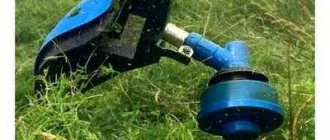Gasoline trimmers have long been used by many summer residents and owners of personal plots.
Their convenience is undeniable, because operation does not require a stationary power source, and the absence of electrical wires allows you to use these devices away from home.
With all this, the devices are quite powerful, and there are professional models among them.
To operate any gasoline trimmer, 2 types of fuels and lubricants (fuels and lubricants) are required, that is:
- petrol;
- oil.
However, the operating principles of two-stroke and four-stroke engines of lawn mowers are different, and this determines how much oil needs to be added per liter of gasoline and what kind of oil can be poured into the engine.
Therefore, next we will tell you:
- how the lubrication system of two-stroke and four-stroke engines works;
- what is the difference between oils for different types of engines;
- what kind of gasoline and what kind of oil is best to pour into a lawn mower with different types of engines;
- what happens if you confuse the type and method of using oil;
- how to dilute gasoline with oil for a lawn mower with a two-stroke engine;
- how much lubricant to pour into four-stroke engines;
- What are the fuel consumption standards?
Lubrication system for two-stroke and four-stroke engines
Four-stroke engines and air-fuel mixture preparation
systems Therefore, the pump supplies oil directly to the rubbing surfaces, that is, the crankshaft bearing and the point of contact of the piston with the cylinder walls.
To do this, the lubricant is poured into a special container, from where it flows through channels to areas of high friction.
In addition, through the crankshaft and connecting rod, oil reaches the piston and washes it , reducing the temperature and lubricating the cylinder walls.
Two-stroke engines do not have a separate lubrication system, but they also have a crankshaft bearing that needs to reduce friction.
In such power units, the air-fuel mixture first enters the crankcase, where the crankshaft bearing is located, and then, under the influence of vacuum, passes by the piston, cooling it and lubricating the cylinder walls, and enters the combustion chamber.
However, gasoline does not have lubricating properties, so such devices are filled with a gasoline mixture, that is, liquid fuel to which special oil has been added.
The efficiency of lubrication with a fuel mixture is much lower than with engine oil, so the service life of a two-stroke engine bearing, and therefore the crankshaft and connecting rod, is noticeably shorter than the same part of a four-stroke engine.
In addition, the two-stroke lubrication system places special demands on the oil, because it must burn as much as possible in the cylinder and form a minimum of toxic substances.
Characteristics
Also, to create a fuel consistency for the first two refuelings, you should add 10% more oil
Fundamentally! The trimmer does not need to be run in, but during initial startup it is better to use only half the power.
You should not prepare a huge amount of fuel mixture, because old fuel does not lubricate the engine.
To extend the life of the motor, adhere to the following rules:
- Do not use bad gasoline . Don't forget to add oil !
- Do not turn on the lawn mower at high speeds without load.
- Do not use lubricant for 4-stroke engines.
After 10 hours of using the gas trimmer, you must:
- Check the condition of the muffler;
- Clean or replace the air filter;
- Check the gap between the spark plug contacts. It should be 0.6-0.7 mm;
- Clean the ventilation holes;
- Add oil to the gearbox.
It is not recommended to carry out independent repairs of the power unit. If any breakdowns occur, you need to take the brush cutter to a service center.
After every 45 minutes of operation, a technical break is taken for 10-15 minutes, while completely turning off the lawn mower. This is necessary to prevent the device from overheating.
How do oils differ for different types of engines?
The different operating principles of the oil system force the use of lubricants with different properties and characteristics.
In addition, in four-stroke engines, oil lasts the entire season, but in two-stroke engines it lubricates the parts, then burns in the cylinder , which also affects the requirements placed on it.
Four-stroke
According to the principle of operation, the four-stroke power unit is completely identical to automobile internal combustion engines.
Therefore, the requirements for lubricating fluid are the same as for conventional motor oil for high-speed automobile engines.
The main parameter of a lubricant for four-stroke engines is viscosity, which describes how fluid the oil will be at operating temperature, and the parameter is designated by the letter “W” and the numbers before and after it.
The numbers in front of the letter describe the minimum negative temperature at which it retains its lubricity, however, this parameter is not relevant for trimmers, because it is not used during frosts.
The numbers after the letter describe the viscosity at operating temperature. Typically, 5W30 or 5W40 lubricant is used for four-stroke trimmers.
Another relatively important oil parameter for four-stroke engines is the type of lubricant, that is :
- mineral;
- semi-synthetic;
- synthetic.
Mineral oil is produced by thermal distillation (distillation) of petroleum and heavy petroleum products. It is cheap, but has mediocre lubricating properties and low resistance to high temperatures.
Synthetic oil is obtained from various gases that come out of the earth along with oil. It is much more expensive, but has noticeably better lubricity and resistance to high temperatures . Semi-synthetics are a mixture of both bases.
However, base oils of any type have extremely mediocre characteristics, so they are modified using various additives that change the properties of the finished product.
Moreover, the requirements for oil depend on the characteristics of the engine and its operating conditions , however, trimmer engines operate in much more comfortable conditions than automobile ones, so oil designed for any engine is suitable for them. For this reason, the containers with lubricating fluid for trimmers do not indicate the API class, that is, compliance with certain automobile engines.
Two-stroke
Since the oil for such engines works only for a few moments, after which it burns in the cylinder, it is not required to have the same durability as the lubricating fluid of four-stroke engines.
In addition, it must have higher lubricity, because such oil reaches the bearing being highly diluted with gasoline.
Since all two-stroke engines of garden equipment operate under approximately the same conditions, the oil for them is not divided by viscosity or any classes.
Two-stroke oil is suitable for a trimmer, even if it is written on the packaging or container that it is intended for the following two-stroke devices :
- lawnmowers;
- chainsaw;
- garden equipment.
An important condition is complete combustion in the cylinder, otherwise the trimmer will greatly pollute the environment, and the smell of its exhaust will be extremely unpleasant.
This is why an incorrectly composed fuel mixture produces thick, dark or bluish exhaust with a sharp, unpleasant odor. The same effect appears when the device is operating with a faulty or untuned engine/carburetor, as well as during severe over-gassing.
Briefly about the main thing
Engine oil for lawn mowers is designed to provide protective lubrication of the engine piston group, ensuring its performance and durability. At the same time, it must mix well with fuel, provide sufficient wear resistance to the interacting elements of the engine, and have a viscosity and fluidity appropriate to the operating conditions.
First of all, oils differ according to the type of engine - for 2-stroke and 4-stroke. The former are mixed with the fuel, the latter are poured into a special tank. In addition, they also differ in a number of other characteristics:
- Type of base – synthetic, mineral, semi-synthetic.
- Type of additives.
- Engine volume.
- The level of harmful emissions.
- Season of operation.
In order to correctly determine which oil to pour into a lawn mower, when choosing, it is necessary to take into account its characteristics such as base number, viscosity, ignition temperature. Filling oil into the trimmer must be carried out strictly in accordance with the rules of use, if necessary, by proper dilution.
What gasoline is suitable for different types of engines?
The motor of any trimmer, regardless of type, is designed to run on AI-92 unleaded gasoline.
However, the engine can also operate on other types of gasoline, for example, AI-76 or AI-95, but this is only permissible for a short time, that is, tens of minutes.
Long-term operation on unsuitable fuel will lead to burnout of valves and other problems , after which the power unit will have to be repaired or replaced, so you need to know exactly what kind of gasoline can be filled with your specific model of brush cutter.
Hitachi CG27EAS(S)
wiz5 Member Topic author
| 8 years on the site user #450532 The price of the winding mechanism, that is, the starter, is about 200 thousand. The Hitachi service center on Budslavskaya 29 is open from 8.30 to 17.00. Are available . gummen Member |
| 9 years on the site user #245476 The price of the winding mechanism, that is, the starter, is about 200 thousand. The Hitachi service center on Budslavskaya 29 is open from 8.30 to 17.00. Are available . there is no point in buying, it’s easier to repair, throw out the spring and work a little with glue, it’s done once and for a very long time. But buying a starter doesn't solve anything. (It’s not nice to advertise your stores and services) kka007 Member |
| 8 years on the site user #519814 Tell! who pours how much, in what proportion, and what kind of oil. Weron-by Member |
| 10 years on the site user #196713 kka007 , I use Titan 2t M oil, the proportions are indicated in the instructions for the trimmer. WRANNIK Member |
| 12 years on the site user #117256 The instructions for the trimmer indicate that you need to use a mixture in proportions from 25:1 to 50:1 Do you understand? PADRE_MAHONY Neophyte Poster |
| 7 years on the site user #743702 Husqvarna oil, diluted 25:1 during break-in, now I pour 100 grams of oil into 3 liters of gasoline, if it sits diluted for a long time, I add another 50 grams. Third season, 10-acre plot, I’m also giving the neighbors a quick job, the flight is normal. And why talk about the starter? gummen Member |
| 9 years on the site user #245476 Damaged starter spring. the real disease of this trimmer. I can post a photo and a suggestion for those who are tired of changing these springs. The instructions for the trimmer indicate that you need to use a mixture in proportions from 25:1 to 50:1 So, understand? pour as it is written on the oil, if it is not written, then 25:1 shvets2209 Neophyte Poster |
| 9 years on the site user #318644 I'm changing the spring for the third time. What to do? Please tell me. gummen , I am changing the spring for the third time. What to do? Please tell me. wiz5 Member Topic author |
| 8 years on the site user #450532 Yes, I work at the Hitachi service center in Minsk, and at the same time I try to help people find spare parts. I don’t buy a starter from us very often, and no matter who buys me a starter or other spare parts. We recommend Hitachi dilute the oil 1:50, or other red oils. I recommend breaking through the mesh in the muffler, it will start and run easier and smoother. Spring article 6684677 price 46700, out of stock now, if anyone needs it, write to us and we will order it. Article number starter assembly 6699995 price 221000 in stock Kazakh zippo club |
| 8 years on the site user #411670 they have a disease - the fuel hose cracks over time. you have to tighten it up. I bought a Husqvarnova one - they said it would be fine. gummen Member |
| 9 years on the site user #245476 View of the repaired starter drum: The simplest solution to the problem. We throw in the spring and glue the ratchet to the drum with glue. Degrease and sand all parts to be glued. The glue must be epoxy based. I use either poxipol or mannol two-component. Everything I did, I didn’t see any more people with this problem. The only drawback of this method is the difficulty of subsequent replacement of the lace. Well, I don’t consider the lack of elastostart a problem. gummen Member |
| 9 years on the site user #245476 And the problem with the starter is due to the poor design of the starter itself. I have seen many starters with elastostart and there is no such problem. Later I will post a photo of the part in which this problem is solved. gummen Member |
| 9 years on the site user #245476 The difference is in the inner sleeve. Timandrey Neophyte Poster |
| 8 years on the site user #547415 People, please tell me, maybe someone knows how this trimmer differs from the CG27EJ(S) model. wiz5 Member Topic author |
| 8 years on the site user #450532 The CG27EJ(S) is quite a bit more powerful, heavier, has a larger tank, the muffler in older versions came without a mesh, different carburetors, a different trimmer switch button (structurally). The starter coil is the same. The cylinder block is different, but the trimmers are approximately the same GDiver Onliner Auto Club |
| 18 years old on the site user #1287 Can anyone tell me where I can buy a shoulder strap separately for this trimmer? shapk Member |
| 9 years on the site user #349400 Can anyone tell me where I can buy a shoulder strap separately for this trimmer? |
What happens if you mix up the type and method of using oil?
If you pour mixture for a two-stroke into a four-stroke engine, the following will happen::
- power will drop;
- fuel consumption will increase;
- spark plugs will quickly fail;
- during long-term operation, the gasket, valves or piston may burn out;
- the smoke will become darker and smellier;
- Over time, the carburetor will clog, so the engine will run poorly even with the right gasoline.
If you pour oil into the fuel instead of the crankcase, then in addition to the troubles described, the crankshaft bearing will soon first knock and then jam, because it cannot work normally without lubrication . If you pour pure gasoline into a two-stroke engine, it will soon fail, because the crankshaft bearing will lose its lubricant.
If you mistakenly add four-stroke oil to the fuel mixture for a two-stroke engine, then:
- the crankshaft bearing will quickly fail;
- over time, the operation of the carburetor will be disrupted;
- valves, piston or gasket will quickly burn out.
Standard proportions
The standard determines that to prepare a gasoline-oil mixture, you will need to take technical fluids in a ratio of 1 to 50. This means that 200 milliliters of oil must be added to 10 liters of gasoline. If you need to dilute the amount per 1 liter of gasoline, then use the formula according to the rule of proportion.
Please note that when using mineral oil, the proportion is smaller and in the standard version per liter of gasoline is 1 to 40.
Fuel to Oil Ratio for Two-Stroke Engines
Oil for such engines is supplied in different concentrations, so for one part of lubricating fluid there are 20–50 parts of fuel , and the correct ratio is indicated on the packaging or container with oil.
To make the right mixture, use special containers (canisters), which indicate the volume of contents at different levels.
First, the optimal proportion of both liquids is determined, then the required amount of gasoline is poured in (tracked by the marks provided for this) and oil is added to a special outlet in the container, and its amount is also tracked by the marks .
When both liquids reach the desired marks, they are mixed together, shaking the canister thoroughly.
Purpose of the lawn mower
The trimmer's task is to care for the lawn, flowerbed or playground, that is, an area with grass that is not very large, but difficult to process.
- Terrain – One of the main obstacles for a wheeled device is the terrain. Bumps, holes, slopes, and artificially created landscapes can only be processed with a very maneuverable tool, which does not include a wheeled vehicle.
- Area – it’s no secret that in a garden plot the area of the flower bed and lawn is minimal. In urban areas, the size of the plots themselves does not allow the formation of extensive gardening. There is simply no need for powerful devices here.
- Duration of continuous operation – the gasoline engine ensures autonomy of the device. Its service life depends on the complexity of processing and the volume of the fuel tank. Of course, breaks in work have to be taken to cool the engine, but judging by the reviews on the forums, the mode cannot be compared with the operating conditions of an electric drive.
- Convenience – the latter largely depends on the design of the device. The shoulder belt, backpack design, protective cover, adjustable handles, etc., greatly facilitate the operator’s task. But all of the above applies to high-quality tools, such as Hitachi lawn mowers.
How much lubricant should I pour into four-stroke engines?
Due to its small size, the trimmer engine crankcase holds 80–200 ml of oil, but the exact value is indicated in the operating instructions and is often written next to the filler plug.
Check the lubricant level with the engine turned off by placing the trimmer on the table and unscrewing the plug to which the dipstick is attached.
Marks on the dipstick help estimate the amount of oil and therefore a lack of lubricant will be immediately detected.
Mixing Rules
To prepare the fuel mixture, you must use clean and dry containers that do not contain foreign matter or contamination. It is not recommended to use plastic containers. After adding liquids in the required proportion, the mixture must be thoroughly mixed for 2-3 minutes. You cannot do the following:
- Add a small amount of oil directly to the gas tank of the brush cutter, as this will not give a homogeneous mixture;
- First of all, fill in oil, and then gasoline. Due to the difference in densities, with this order of adding components, a heterogeneous mixture is also obtained4
- Measuring components by eye. With this approach, it will not be possible to achieve the exact proportion of gasoline and oil for a trimmer of 1/50 or 1/40;
- Use polyethylene bottles, since the latter is dissolved by gasoline.
Consumption rates for fuels and lubricants
Fuel consumption for gasoline trimmers depends on:
- engine power;
- engine volume;
- state of the power unit;
- grass characteristics;
- operator skills.
Therefore, fuel consumption is individual for each engine, and also changes in different situations.
This parameter is measured in various units, the most popular of which are:
- g/kWh (grams per kilowatt-hour of engine power);
- l/hp h (liters per horsepower per hour);
- liters per square meter or hundred square meters (100 m2).
Manufacturers do not always indicate the actual fuel consumption of this or that trimmer, so the owner of such a device will have to find out this parameter experimentally. Usually this parameter fits into 0.3–2 liters per hundred square meters .
Oil consumption for two-stroke engines is always tied to the amount of fuel and corresponds to the fuel mixture ratio set by the lubricant manufacturer.
The amount of oil for a four-stroke engine is always the same, because it is changed once a season.
Review of trimmers and lawn mowers of the Hoper brand
The development of the Khoper brand on the Russian market began in 2010. The position became stronger over time thanks to the successful design of the equipment and the use of inexpensive but high-quality materials. To reduce the cost of products, all capacities were transferred to China, but this did not affect the quality. Large-scale assembly is carried out on the territory of Russia. The Hoper company also produces a wide range of component materials.
Trimmer Hopper
The popularity of the Khoper brand was facilitated by the fact that most of the technical characteristics were copied from the popular brands Zirka and Kadvi. Thanks to multi-stage control carried out in production, Hoper products are not inferior in quality to well-known brands.
The Hopper product line is represented by various models of trimmers and trimmers with a gasoline engine. All models are distinguished by reliability, build quality and long service life.
Sources:
https://fermerzag.ru/trimmery-i-motokosy/kak-obkatat-trimmer-benzinovyj-hoper-043.html https://fermerinform.ru/trimmeri-motokosi-hoper-obzor/ https://openfile.ru /dacha-i-sad/%D0%BE%D0%B1%D0%B7%D0%BE%D1%80-%D1%82%D1%80%D0%B8%D0%BC%D0%BC%D0 %B5%D1%80%D0%BE%D0%B2-%D0%B8-%D0%BC%D0%BE%D1%82%D0%BE%D0%BA%D0%BE%D1%81-% D0%B1%D1%80%D0%B5%D0%BD%D0%B4%D0%B0-%D1%85%D0%BE%D0%BF%D0%B5.html
How to fill with fuel?
In four-stroke trimmers, pour both liquids into the corresponding holes, closed with sealed lids.
If you spill any liquid during pouring, remove it with a clean, dry cloth , do not leave it on the body.
Two-stroke engines have only one hole for pouring mixture into the tank.
Remember, the mixture for two-stroke engines must be used within two weeks, after which the mixture will lose its lubricating properties, so the crankshaft bearing will run dry without lubrication, which will lead to it seizing and expensive repairs.
the fuel using a funnel, so there is less chance of spilling it , but with sufficient skill, it can be poured immediately from a mixing canister or even a plastic bottle.
Recommendations for selection
When choosing oil for a trimmer, the following number of parameters are taken into account:
- Alkalinity. The reaction of the medium should be alkaline - within 8-9 units. The smaller it is, the faster the oil acidifies and leads to oxidation of the engine.
- Viscosity. The higher the parameter, the faster the product thickens as the temperature drops. Ideally, it should be precisely selected for the operating temperature conditions.
- Ignition temperature. As a standard, its value should not be lower than 2250C. Otherwise, the oil will quickly burn out and lead to defects in the piston group.
Benefits of branded oils
STIHL , Husqvarna and Makita have the highest ratings
Only in certain parameters the branded assortment is inferior to domestic motor oils of the Lukoil brand.
The list of advantages of branded motor oils:
- economical consumption;
- stability of performance characteristics under difficult operating conditions and during long-term storage;
- minimal amount of toxic compounds in exhaust gases;
- almost complete absence of soot.
HOW TO CORRECTLY DILUTE GASOLINE WITH OIL 1:50
According to the American classification, oils of the API-TB category can be used for work in household and professional models. The Japanese equivalent is JASO-FB and JASO FD. Preparation of a flammable mixture using oil for 4-stroke engines is strictly prohibited.
Red, green or any other color of the oil determines whether the product belongs to the range of a particular manufacturer, and therefore is not taken into account when determining the characteristics of the material. You should be extremely careful when choosing motor oil of unknown composition and origin.
Until additional information about quality and operational parameters is obtained, it is better to temporarily abandon the use of such material.
It is allowed to mix motor oils of the same type in composition and purpose produced by brands known for the quality of their range. Under no circumstances is it permitted to mix mineral and synthetic oils.










